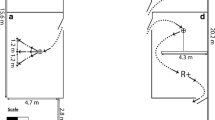Abstract
A conveyor belt task for assessing visuo-motor coordination in the marmoset is described. Animals are motivated by apple, a preferred food, under a state of minimal food deprivation. The apparatus used was designed to test animals within their home cages and not restrained in any way, thus avoiding possible confounding factors associated with restraint stress. Stable baseline levels of performance were reached by all animals in a median of 24 sessions. Performance was shown to be differentially sensitive to the effects of four psychoactive drugs. Moderate doses of diazepam, chlorpromazine and pentobarbital disrupted visuomotor coordination in a dose-related manner. The possibility that disruption of performance observed at higher doses may have resulted from non-specific actions of these drugs such as decreases in feeding motivation were not supported by results from ancillary experiments. Changes in performance characteristic of high dose effects were similar in nature to changes observed when the degree of task difficulty was increased. Doses of d-amphetamine up to and including those reported to produce signs of stereotypy failed to influence performance. The potential of the conveyor belf task for measuring visuo-motor coordination in both primate and rodent species is discussed.
Similar content being viewed by others
References
Bartus RT, Johnson HR (1977) Primate information processing under sodium pentobarbital and chlorpromazine: Differential durg effects with tachistoscopically presented discriminative stimuli. Psychopharmacology 53:249–254
Beck CH, Chambers WW (1970) Speed, accuracy and strength of forelimb movement after unilateral pyramidotomy in rhesus monkeys. J Comp Physiol Psychol 70:1–22
Borland RG, Nicholson AN (1974) Human performance after a barbiturate (heptabarbitone). Br J Clin Pharmacol 1:209–215
Brady JV, Bradford LD, Hienz RD (1979) Behavioural assessment of risk-taking and psychophysical functions in the baboon. Neurobehav Toxicol 1:73–84
Brinkman J, Kuypers HGJM (1973) Cerebral control of contralateral and ipsilateral arm, hand and finger movements in the split-brain rhesus monkey. Brain 96:653–674
Bush M, Custer R, Smeller J, Bush LM (1977) Physiologic measures of non-human primates during physical restraint and chemical immobilisation. J Am Vet Med Assoc 171:866–869
Campos F, Arruda F (1981) Pharmacologic manipulations of brain catecholamines and the behaviour of Callithix Jacchus (marmoset). Psychopharmacology 73:252–256
Clement JG (1984) Sodium pentobarbital alteration of the toxicity and distribution of soman (pinacolyl methylphosphofluoridate) in mice. Biochem Pharmacol 33:683–685
Ettlinger G, Kalsbeck JE (1962) Changes in tactile discrimination and in visual reaching after successive and simultaneous bilateral posterior parietal ablations in the monkey. J Neurol Neurosurg Psychiatr 25:256–268
Evenden JL, Robbins TW (1984) Effects of unilateral 6-hydroxydopamine (6-OHDA) lesions of the caudate-putamen on skilled forepaw use in the rat. Behav Brain Res (in press)
Falk JL (1969) Drug effects on discriminative motor control. Physiol Behav 4:421–427
Feinberg TE, Pasik T, Pasik P (1978) Extra geniculostriate vision in the monkey. VI. Visually guided accurate reaching bahaviour. Brain Res 152:422–428
de Gier JJ, 'tHart BJ, Nelemens FA, Bergman H (1981) Psychomotor performance and real driving performance of outpatients receiving diazepam. Psychopharmacology 73:340–344
Godschalk M, Lemon RN, Nijs H, Kuypers HGJM (1981) Behaviour of neurons in monkey peri-arcuate and precentral cortex before and during visually guided arm and hand movements. Exp Brain Res 44:113–116
Goodman AG, Goodman LS, Gilman A, eds (1980) The pharmacological basis of therapeutics. New York: MacMillan
Hamilton CR (1967) Effects of brain bisection on eye-hand coordination in monkeys wearing prisms. J Comp Physiol Psychol 64:434–443
Harlow HF (1950) Learning and satiation of response in intrinsically motivated complex puzzle performance by monkeys. J Comp Physiol Psychol 43:289–294
Hart J, Hill HM, Bye CE, Wilkinson RT, Peck AW (1976) The effects of low dose amylobarbitone sodium and diazepam on human performance. Br J Clin Pharmacol 3:289–298
Hartje W, Ettlinger G (1973) Reaching in light and dark after unilateral posterior parietal ablations in the monkey. Cortex 9:346–354
Hienz RD, Lukas SE, Brady JV (1981) The effects of pentobarbital upon auditory and visual thresholds in the baboon. Pharmacol Biochem Behav 15:799–805
Johanson CE, Aigner TC, Seiden LS, Schuster CR (1979) The effects of methamphetamine on fine motor control in rhesus monkeys. Pharmacol Biochem Behav 11:273–278
Jolly A (1964) Prosimians' manipulation of simple object problems. Anim Behav 12:560–570
Leary RW, Ruch TC (1955) Activity, manipulation drive, and strength in monkeys subjected to low-level irradiation. J Comp Physiol Psychol 48:336–342
Lewandowska EAM (1981) A method for screening the effects of drugs on manual coordination in the marmoset. Br J Pharmacol 72:484P
McDowell AA, Nissen HW (1959) Solution of a bi-manual coordination problem by monkeys and chimpanzees. J Gen Psychol 94:35–42
Milner G, Landauer AA (1971) Alcohol, thioridazine and chlorpromazine effects on skills related to driving behaviour. Br J Psychiatr (Engl) 118:351–352
Myers RE, Sperry RW, McCurdy NM (1962) Neural mechanisms in visual guidance of limb movements. Arch Neurol Chicago 7:195–202
Napier JR, Napier NH (1967) A handbook of living primates. New York: Academic Press, pp 396–399
Newson TJ, Jaeger RJ, Bachman JA (1976) Training and performance of rhesus monkeys as operators in a compensatory manual control system. Percept Mot Skills 42:695–705
Pragay EB, Mirsky AF (1973) The nature of performance deficit under secobarbital and chlorpromazine in the monkey. Psychopharmacologia 28:73–85
Samson HH, Falk JL (1974) Ethanol and discriminative motor control: Effects on normal and dependent animals. Pharmacol Biochem Behav 2:791–801
Scraggs PR, Ridley RM (1978) Behavioural effects of amphetamine in a small primate: Relative potencies of the d-and l-isomers. Psychopharmacology 59:243–245
Shimwell M, Warrington BF, Fowler JSL (1979) Dietary habits relating to ‘wasting marmoset syndrome’ (WMS). Lab Anim 13:139–142
Siegel S (1956) Non-parametric statistics for the behavioural sciences. New York: McGraw-Hill
Weiss B, Laties VG (1962) Enhancement of human performance by caffeine and the amphetamines. Pharmacol Rev 14:1–36
Wetherell A (1979) Individual and group effects of 10 mg diazepam on drivers' ability, confidence and willingness to act in a gapjudging task. Psychopharmacology 63:259–267
Winer BJ (1971) Statistical principles in experimental design. 2nd ed. London, McGraw-Hill
Wittenborn JR (1979) Effects of benzodiazepines on psychomotor performance. Br J Clin Pharmacol 7 Suppl 1:61S-67S
Author information
Authors and Affiliations
Rights and permissions
About this article
Cite this article
D'Mello, G.D., Duffy, E.A.M. & Miles, S.S. A conveyor belt task for assessing visuo-motor coordination in the marmoset (Callithrix jacchus): Effects of diazepam, chlorpromazine, pentobarbital and d-amphetamine. Psychopharmacology 86, 125–131 (1985). https://doi.org/10.1007/BF00431696
Received:
Accepted:
Issue Date:
DOI: https://doi.org/10.1007/BF00431696




